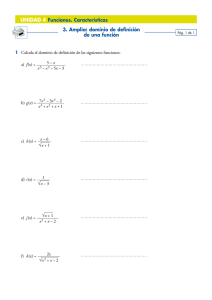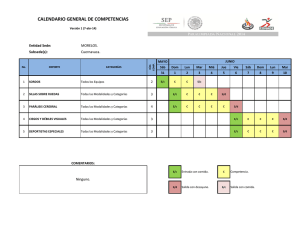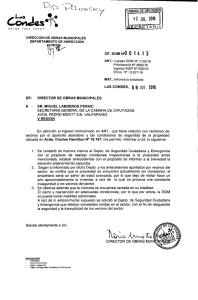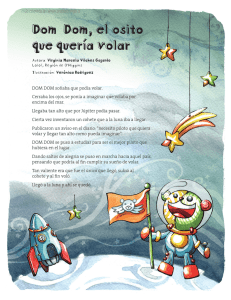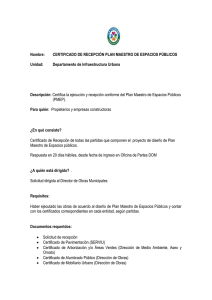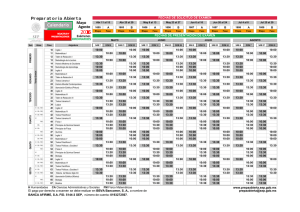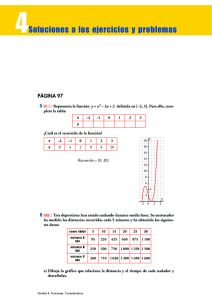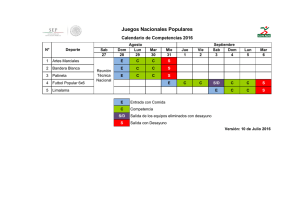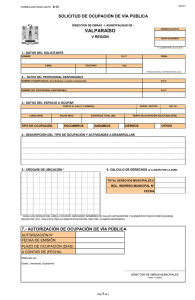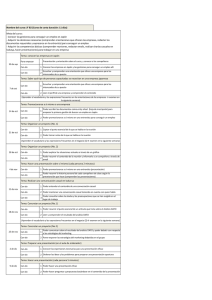Toni Mateos - Can Do Musos
Anuncio
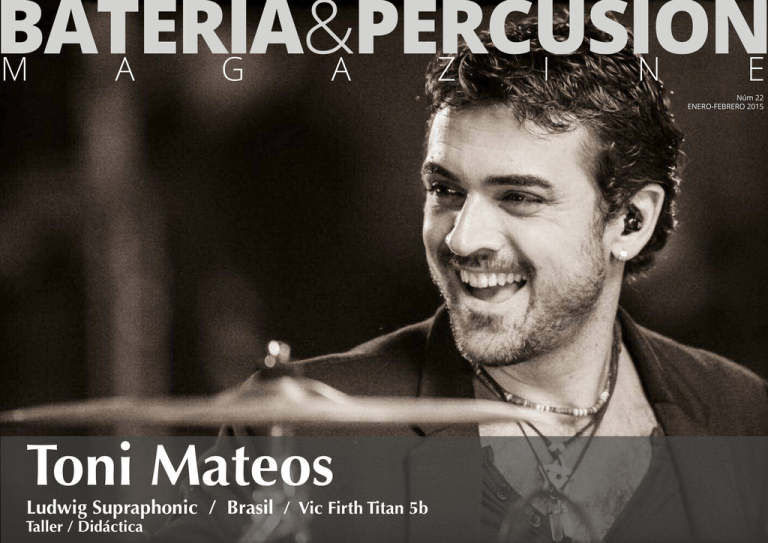
BATERIA&PERCUSION M A G A Z I N E Núm 22 ENERO-FEBRERO 2015 Toni Mateos Ludwig Supraphonic / Brasil / Vic Firth Titan 5b Taller / Didáctica ENTREVISTA Asensio Ros “Wally” David Segal Querer es poder ENTREVISTA David Segal, es un batería y pedagogo musical responsable de Can-DoMusos una organización para aprendizaje, promoción y ayuda al músico discapacitado. Contactamos con él para que nos contara su experiencia y su proyecto. Estos nos comentó Amigos, David Segal Acerca de ti, cuéntanos tus inicios y tu trayectoria como músico Nací con Artrogriposis, enfermedad que afecta al desarrollo de los huesos, los músculos y los nervios de las extremidades y requiere 12 cirugías correctivas. Crecí en la ciudad de Nueva York y comencé a tocar la batería de niño con U2 en 1983. Una de las cosas que tenía que averiguar era cómo sostener el palo con la mano izquierda. Fue por entonces cuando empecé a estudiar con Fred Klatz, un gran batería y maestro. Con Fred nos ingeniamos una serie de muñequeras con Velcro que me permitieran sostener la baqueta. Me tomó mucho tiempo, ya que era muy extraño tener que lidiar con la mano izquierda. Fred y yo trabajamos en la lectura de música, ritmos básicos de rock y los elementos básicos del jazz. Fue entonces cuando empecé a acionarme a los grandes bateristas de jazz como Elvin Jones y Buddy Rich, con el que tengo una gran historia. Mi padre y yo estábamos en la tienda de ropa de Fred Segal en Santa Mónica California, y Buddy Rich pasó por allí. Mi padre quería que me acercara a saludarle. Le dije que no, era un niño tímido. Mi padre se presentó a él, le habló de mí y Buddy dijo: “Dile a David que me llame cuando esté en Nueva York”. Así que nalmente me armé de valor para llamarle y no podría haber sido mejor. Me invitó a varios conciertos. Fred Klatz, mi profesor de batería, actuó como mi acompañante a verlo a SOB’S y en South Street Seaport. Fuimos invitados al autobús después de un concierto para hablar, pasar el rato y también me dieron un par de baquetas. Fue una gran experiencia. En la década de los 90 continué estudiando y desarrollándome hacia el Rock. Me uní a la banda de rock & M ne I e ENE E indie The Sin Taxes y ayudé a producir y grabar su cd debut. Tocamos en muchos sitios y nos pusieron en 30 estaciones de radio de todo el país, en algunos mercados principales. También hice las promociones de radio de la grabación. En 2002 empecé a ir cada año al KoSa Drum Camp dirigido por Aldo Mazza y que iba a cambiar mi vida para siempre. Allí conocí y me hice amigo de muchos de mis ídolos con los que crecí. Estudié con Dom Famularo, Mario Mónaco, Memo Acevedo, Liberty DeVitto, Arnie Lang, Kenwood Dennard, Bernard Purdy y otras leyendas de la industria. Totalmente inspirado volví a la escuela y recibí una licenciatura en Música de la Universidad y luego una maestría en Educación Musical en Lehman College. Comencé a estudiar con Dom Famularo en 2004, quien mejora aún más la idea original de la muñequera. Hemos trabajado en la técnica de Moeller, tocando con la música y los solos. También trabajamos en estrategias de marketing e ideas de negocio. Se convirtió en no sólo un profesor de batería, sino un profesor de la vida. Fueron estos tipos de conversaciones los que acabaron en Can-Do Musos. En 2011, mi amigo y maestro Memo Acevedo me presentó a dos personas increíbles, Carol Calato de Regal Tip, de los que soy endorser y el Dr. Louis Gaston respalda desde G.R.I.P. Solutions, que en ese momento estaban trabajando en un dispositivo que permitiera a los bateristas con limitaciones físicas agarrar una baqueta Tuve la oportunidad de viajar a Pittsburgh, en marzo del 2012 donde el Dr. Gaston hizo una férula que mejoró signicativamente la movilidad de mi mano izquierda para moverse por la batería. 11 ENTREVISTA Nuestros objetivos son llevar el músico discapacitado a la corriente principal. El 24 de enero 2014 toqué en el Carnegie Hall de Nueva York con el NYJA Jazz Orchestra como parte de la “China Meets America Cultural Festival’ Actualmente enseño en una escuela privada superior en Connecticut y tengo mi propio Home Studio para grupos e individuales y sesiones de grabación. En octubre de 2014 llevé a cabo en un festival patrocinado por VSA Vermont. Es una organización sin ánimo de lucro para las artes y la educación que utiliza las artes para desarrollar capacidades y aumentar la conanza de los niños y adultos con discapacidades. El BOOM VT Festival reunió a músicos con discapacidad y sin discapacidad para tocar e inspirar. Tuve el gran placer de tocar con el miembro de la facultad de KoSa Je Salisbury, y compañero de batería, en un dueto en solitario. Como se te ocurrió y surgió la idea de CanDo- Musos. Empezamos CandoMusos.com en marzo de 2013 en Dom´s Wizdom Drumshed en Long Island, Nueva York. Presentes estaban Dom Famularo, Mike Mignogna, Andrew Hewitt y yo mismo. Desde Dom tenía un número de estudiantes discapacitados y colegas y todos pensamos que podríamos unirnos y hacer algo más grande que marcaría la diferencia con los músicos con discapacidad apasionados. Fue con este espíritu que Can–Do- Musos nació. Preséntanos este proyecto, en qué consiste, como funciona… Can-Do Musos se estableció para convertirse & M ne I e ENE E en la voz global para los músicos con problemas de todo el mundo. El objetivo es promover y ayudar a todos los músicos con algún tipo de discapacidad, ayudándoles a reducir la brecha entre el talento y las limitaciones mientras proporciona apoyo y acceso a los recursos. El nombre proviene de la idea de que tener una “actitud Can-Do (Yo Puedo)” es el primer paso hacia el éxito. “Muso” es un término usado en Inglaterra y Australia para describir músicos con una pasión y dedicación a su música. Las dos palabras unidas juntas forman un nombre único que dene tanto nuestra visión y misión. Se inicia con un músico enviándonos su información a [email protected]. Explicando qué tipo de discapacidad tienen, sus antecedentes, etc. A continuación, nos pondremos en contacto con ellos para darles publicidad en candomusos.com. También tenemos un programa de Can-Do Radio semanal donde podemos poner su música. Nuestro objetivo es hacer conciertos, giras y eventos en el futuro. Tenemos nuestras páginas de red sociales, donde también ofrecemos a nuestros miembros en Facebook y Twitter. A 19 de enero 2015 tenemos unos 145 miembros de 18 países. ¿Qué pretendéis, objetivos con esta fabulosa propuesta? Nuestros objetivos son llevar el músico discapacitado a la corriente principal. En 2015 el equipo Can-Do-Musos como presenta nuestra visión global en el NAMM 2015 en Anaheim, California el domingo 25 de enero a las 3. NAMM 12 ENTREVISTA es una de las mayores ferias de música en América del Norte. Estás rodeado de la ONU equipo de grandes profesionales, Háblanos de tu equipo, Dom Famularo, Andrew Hewitt, y Mike Mignogna. Mike Mignogna nació con parálisis cerebral y en la ciudad de Tennessee. Toca la batería desde que tenía 11 años de edad, y tiene funciones limitadas en sus piernas. Mike no ha dejado que esto le impidiera tocar y lo narra en un libro titulado “Look Ma No Feet” (Mira Mamá, sin piernas). Es un enfoque práctico para alguien con un uso limitado o nulo de sus piernas. Andrew Hewitt, quien es oriundo de Australia y también tiene parálisis cerebral, acaba de llegar de California para reunirse con nosotros después de dar una presentación en The Rhythm Arts Project (TRAP). A pesar de estar en una silla de ruedas ha viajado por todo Australia dando clínicas y tocando. Andrew, Mike y Dom tocaron juntos en el Australia´s Ultimate Drummers Weekend 2009 en Melbourne. Dom Famularo un gran embajador de la percusión, vio la unidad que los cuatro tuvimos y ayudó a canalizar nuestras energías en una nueva organización que, aunque iniciada por cuatro bateristas, fue creada para capacitar a todos los músicos con discapacidad. Hace varios meses hemos añadido a nuestro nuevo miembro de la Junta a Joe Hardy, quien nació sin piernas y tiene un drumset integrado en su silla de & M ne I e ENE E ruedas. Él es el baterista de la banda de rock alternativo Unit 287 y ha estado tocando la batería durante más de 30 años. Su experiencia ha incluido todo, desde el Heavy Metal al Country Rock y un poco de Jazz. Su estilo de batería ha sido descrito como contundente y poderoso. 13 David Segal, is a drummer and musical educator responsible for Can-Do Musos an organization for learning, promotion and support the disabled musician. We contacted him to tell us his experience and the project. He told us ... Friends, David Segal About you, tell your beginnings and your career musician I was born with arthrogryposis, a disease that affects development bones, muscles and nerves of the limbs and requires 12 corrective surgeries. I grew up in the city of New York and began playing drums Child with U2 in 1983. One of the things I had to figure out was how to hold the stick by left hand. It was then that I began to study with Fred Klatz, a great drummer and master. With Fred we contrive a number of wristbands with Velcro to allow me to hold the stick. It took a long time, as it was very strange to have to deal with the left hand. Fred and I work on reading music, basic rock rhythms and basic elements Jazz. That's when I started to admire the great jazz drummers like Elvin Jones and Buddy Rich, with whom I have a great story. My father and I we were in the clothing store Fred Segal in Santa Monica California, and Buddy Rich came by. My father wanted me to come to greet him. I said no, it was a shy child. My father was presented to him and spoke of Me and Buddy said, "Tell David to call me when you arrive in New York ". So I took the plunge and got the courage to call and could not have been better. I was invited to several concerts. Fred Klatz, my drum teacher, acted as my companion to see him SOB'S and South Street Seaport. We were invited to the bus after a concert to talk, hang out and I also got a pair of drumsticks. It was a great experience. In the 90s I continued studying and developing myself to the Rock. I joined the indie rock band, The Sin Taxes and I helped produce and record their debut cd. We played at many places and were played on 30 radio stations across the country, in some major markets. I also did promotions radio recording. In 2002 I started going every year at KoSA Camp Drum directed by Aldo Mazza and that would change my life forever. There I met and became friends with many of my idols with which I grew up. I studied with Dom Famularo, Mario Monaco, Memo Acevedo, Liberty DeVitto, Arnie Lang, Kenwood Dennard, Bernard Purdie and other industry legends. Fully inspired I returned to school and received a Bachelor of Music at University and then a Masters in Musical Education at Lehman College. I began to study with Dom Famularo in 2004, who further enhances the original idea of the wristband. We worked on the Moeller technique, playing with music and solos. We also work on marketing strategies and business ideas. Became not only a drum teacher, but a teacher life. It was these types of onversations which resulted in Can-Do Musos. In 2011, my friend and teacher introduced me Memo Acevedo two amazing people, Carol Calato Regal Tip, of which I am endorser and Dr. Louis Gaston supports from G.R.I.P. Solutions. They were working on a device that would allow drummers with limited grip for a drumstick I had the opportunity to travel to Pittsburgh, in March 2012 where Dr. Gaston made a splint that significantly improved my mobility in my left hand to move the drum stick. Our goals are to bring the disabled musician into the mainstream. On January 24, 2014 I played at Carnegie Hall New York with Nyja Jazz Orchestra as part of the "China Meets America Cultural Festival ' I currently teach in a private high school in Connecticut and have my own Home Studio for groups and individual sessions. In October 2014 I took part in a festival sponsored by VSA Vermont. It is a non-profit organization for arts and education that uses the arts to build capacity and increase the confidence of children and adults with disabilities. The BOOM Festival brought together musicians VT with and without disabilities to play and inspire. I had the great pleasure of playing with the faculty member of KoSA Jeff Salisbury, and partnered in a duet solo. How did you come up with the idea of Can-Do-Musos? CandoMusos.com started in March 2013 Dom Famularo's Wizdom Drumshed on Long Island, New York. Present were Dom Famularo , Mike Mignogna, Andrew Hewitt and myself . Since Dom had a number of disabled students and colleagues and we all thought we could get together and do something larger that would make a difference with passionate musicians with disabilities. In this spirit, Can-Do Musos was born. Introduce us this project, what it is, how it works? Can-Do Musos was set to become the global voice for musicians with problems worldwide. The objective is to promote and help all musicians with some kind of disability, helping to bridge the gap between talent and constraints while provides support and access to resources. The name comes from the idea that having a "Can-Do attitude (I Can)" is the first step to success. "Muso" is a term used in England and Australia to describe musicians with a passion and dedication to his music. The two words joined together form a name that defines both our vision and mission. It starts with a musician sending us your information to [email protected]. Explaining what type of disability they have, their background, etc. Then we will contact them to give them publicity on www.candomusos.com. We also have a Can-Do Weekly Radio program where we can play their music. Our goal is doing concerts, tours and events in the future. We have our social network pages, where we also offer our members on Facebook and Twitter. As of January 19, 2015 we have about 145 members from 18 countries. You present objectives with this fabulous proposal? Our goals are to bring the disabled musician to the mainstream. In 2015 the Can-Do Musos Team presents our overview at NAMM 2015 in Anaheim , California Sunday January 25 at 3. NAMM is one of the largest music fairs in North America. Tell us your team, Dom Famularo, Andrew Hewitt, and Mike Mignogna. Mike Mignogna born with Cerebral Palsy and lives in the state of Tennessee. He has played drums since he was 11 years old, and has functions limited in their legs. Mike has not let this stop him from playing and as told in his book entitled "Look Ma No Feet"(Look Ma, no legs). It is a practical approach for someone with limited or zero movement in their legs. Andrew Hewitt, who hails from Australia and has cerebral palsy, had just arrived from California to meet with us after giving a presentation at The Rhythmic Arts Project (TRAP). Despite being in a wheelchair he has travelled all over Australia giving clinics and playing. Andrew, Mike and Dom played together at Australia’s Ultimate Drummers Weekend in Melbourne in 2009. Dom Famularo, a great ambassador for drums and percussion, saw unit the four of us had and helped channel our energies into this new organization, although initiated by four drummers, was created to train all musicians with disabilities. Several months ago we added our newest board member Joe Hardy, who was born without legs and has a drum set built into a wheelchair. He is the drummer for alternative rock Unit 287 and has been playing drums for more than 30 years. His experience has including everything from Heavy Metal the Country Rock and a little Jazz. His drumming style has been described as strong and powerful.
